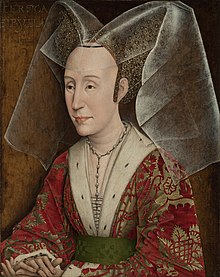Hennin

The hennin ([ enɛ ] fr. ) Is a hood for women in acute or obtuse conical shape of which a long veil , Flinders called suspended. Hennin became fashionable in France in the 14th and 15th centuries , but especially in Burgundy and Flanders . That is why it is also called the Flemish or Burgundian bonnet . From here it spread to the Netherlands , Italy and Germany .
construction
The hennin was a frame made of cardboard , brass wire or whalebone , which was covered with a fine fabric and provided with a beaded or embroidered border made of colored or patterned velvet or cloth. This frame was either surrounded by a veil or with stiffened, deeply creased linen , which fell only to the forehead at the front, but deeply at the back. The hennin ended at the bottom with an embroidered border, over which a broad, dark velvet strip was laid from around 1460 .
The hood was set far back so that as little of the hair as possible remained visible. The design of the Hennin took on adventurous forms over time. Noble women brought it to lace hoods up to a meter in height, civil women, however, were not allowed to go beyond 60 centimeters. Hennins did not go out of fashion until the second half of the 15th century. Successors of Hennin can still be found today in traditional Normandy costumes .
origin
It is said that the Hennin was bought in the 15th century by Isabeau , the wife of King Charles VI. was raised by France . Originally, however, it goes back to a conical headgear for women from the Arab cultural area, which is called turtur or tantur and was made of chased silver. It is still worn by Algerian women today. The French name Hennin probably comes from the Arabic hanini , which means something like "lovely sounding", or from the Dutch henninck , which means "rooster".
Double hennin
A special form of the hennin shows two laterally protruding "horns", this double hennin is therefore also called horned hood . It was in vogue in Central Europe from 1450 to 1480.
Popular culture
A high, pointed hennin is often part of the princess or fairy costume in carnival , not least because it looks dramatic and is easy (cheap) to make.
literature
- Hennin . In: Meyers Konversations-Lexikon . 4th edition. Volume 8, Verlag des Bibliographisches Institut, Leipzig / Vienna 1885–1892, p. 383.
